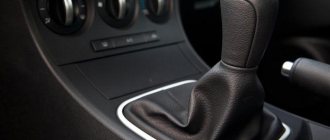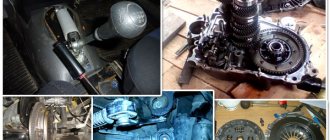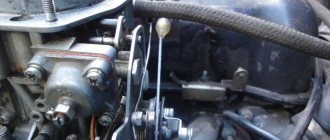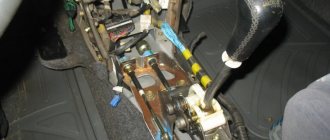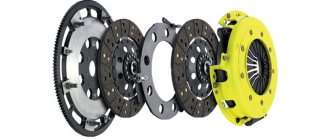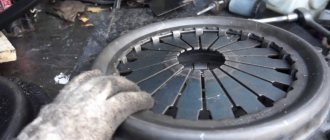The car's transmission allows you to change the torque from the internal combustion engine before transmitting it to the drive wheels. This makes it possible to change the speed of the vehicle, maintain engine operation in the optimal speed range, etc.
Also, thanks to the gearbox, you can change the direction of movement, that is, the vehicle gets the opportunity to move not only forward, but also backward. At the same time, on cars for forward movement, step boxes have several gears, while there is only one reverse speed.
It should be noted that quite often drivers encounter a malfunction when reverse gear does not engage, and on different types of gearboxes (manual transmission, automatic transmission, manual transmission, etc.). Next, we will look at the main reasons why reverse gear does not engage in manual transmissions, as well as in automatic transmissions.
Causes of gearbox failure
The complex mechanism constantly works under load and under extreme conditions. Constant vibration, rising temperatures, dust and dirt. If one or more speeds fail to turn on, you should check:
- cable tension and integrity;
- fastening the scenes;
- wear on the clutch disc;
- petals on a basket;
- bearing integrity;
- plug condition.
Clutch
When the clutch discs wear out, the pedal moves up and its position becomes higher than the others. In this case, when turned on, a crunching sound may be heard and the lever does not move, as if it is resting against an obstacle. You should not force the assembly, as this can lead to more serious damage - the gears will fly.
It is typical for such wear that the clutch pedal falls to the floor and you can hear from drivers that the VAZ 2109 does not engage the gears. Usually this applies to all gears, but only first and reverse can fail.
You can check by removing the rubber plug. The destroyed disc leaves fibers that look like tangled strands of hair. If such a phenomenon occurs, then a new clutch disc should be installed.
Cable
Due to constant loads, the cable stretches and must be periodically adjusted and tightened. In this case, the VAZ 21093 does not engage the first and second gears, and the rear may also fail. To fix the breakdown, you need to drive into the pit and tighten the cable. If it is worn out, replace it immediately. You can do this yourself.
A similar breakdown can also manifest itself in the failure of the gears to engage while the engine is running. Sliding along the splines is limited and fixation does not occur.
Basket
The reason for difficult shifting of individual gears, especially if there is a crackling sound that gradually fades while moving, may be the destruction of the spacer ring in the basket. Notice that there are drops of oil on the outside. Then remove the basket and check the O-ring and disc blades. Pay attention when purchasing new parts, because on some models the disk is missing and then you have to install pins and secure it yourself.
Backstage
A loose link must be tightened with an assistant. No special knowledge or skills are required, just the ability to hold the lever in the desired position while you crawl under the car and tighten the bolts. When the scenes on the VAZ 2109 are loosened, the speeds do not engage, and especially the rear ones.
Place the car on a hole or hill to have access to the bottom. Set the lever to neutral if several speeds do not engage. When only the reverse gear does not work, make adjustments using it. An assistant must hold the shift knob in the specified position without moving it anywhere.
It is necessary to loosen the bolt from below by 13, check the engagement of the gears, and having installed everything in place, tighten the bolt. If there is a problem with several gears, everything is done the same way, but it is set to neutral, or rather the shift knob is in the middle position. You can watch the video on how to do this.
Fork
Most often it fails on the road. If you slow down at a traffic light, the speed will not turn on to continue driving. A crack that forms on the fork body can lead to its destruction at any time, even under minor loads.
Causes
The reasons why reverse gear is poorly or poorly engaged may be the following:
- weakening of the fastening clamp of the rocker, due to which the length of the rod is not enough to actually engage the gear;
- jamming of the reverse speed lock;
- spring breakage and debris getting into the guide grooves of the gear selection mechanism;
- spontaneous loosening of the selection mechanism mounting bolts;
- the clamp bolt is cut off;
- wear of the clutch disc and release bearing;
- incorrect adjustment of the clutch and clutch pedal;
- low oil level in the box or the need to change it.
Backstage adjustment
If tightening the clamp does not help get rid of the problem, then you need to check the condition of the shift drive parts. One of the reasons why reverse gear
To make adjustments to the mechanism, the following tools may be useful:
- two wrenches with a size of 13 mm, preferably a socket design;
- at least some wrench or 10 mm socket;
- small hammer;
- slotted screwdriver.
Since the cause of incorrect operation of the slide can be wear of parts, spare parts may come in handy:
- universal joint of the rocker;
- The shift rod seal may need to be replaced from time to time.
The backstage option or replacement of its drive parts requires two people. One person must change gears from the passenger compartment, and the second person must adjust the travel of the shift rods.
- Provide access to the bottom of the car by placing it on a pit or a lift.
- Using a 13 mm wrench, loosen the clamp mounted on the gear shift rod.
- Remove the rod from the box rod.
- Using a screwdriver, carefully remove the boot.
- Using a 10 mm wrench, unscrew the fixing bolt on the cardan shaft.
- Knock off the cardan shaft with light blows of a hammer. In all this, it is important not to damage the shaft.
- Remove the universal joint seal boot.
- If there is an oil leak, it is necessary to change the sealing gland on the box rod.
- Install a new boot (or discard the old one if it is intact) and install the universal joint on the shaft.
- Align the hole on the cardan with the notch on the shaft.
- Tighten the 10 mm clamp and install the boot one hundred percent in place.
- Install the rod on the cardan rod and adjust the gearshift lever travel.
- The second person should sit in the driver's seat, set the gear shift lever to neutral, move it slightly to the right and hold it in this position.
- Then you need to tighten the 13 mm clamp nut.
READ Tesla's Strong Q4 Caps Its First Full Year of Profitability
Usually, after such a repair, the reverse gear starts to shift into gear without any problems. In addition, the operation of the entire gear selection mechanism on the VAZ-2109 becomes clearer.
First speed is not fixed
When starting to move from a standstill at first speed, especially from difficult ground such as sand and snow, you have to hold the gear shift lever, since it does not hold on its own, the gear is switched to neutral. There can be three reasons for this failure:
- The link is loose and does not fix the fork;
- gear and coupling wear;
- displacement of the engine on the mounts and knocking out the box.
The condition of the fasteners of all parts and assemblies should be completely checked. The gearbox is rigidly fixed to the engine. However, when the motor slides on cushions, the first speed may be knocked out. Tighten all bolts and check the rigidity of the mounting on the body. You can do this kind of work yourself.
Fasten the link more rigidly to the shift lever, select the backlash, because it is responsible for fixing the lever in the desired position. To do this, you need to put the car in a pit. Open the lid and check. Pay special attention to the condition of the gearing.
When worn, gears can slip and jump out without transmitting torque. When you press the lever with your hand, the clutch adheres forcefully and engagement occurs.
New box
There are problems when the car is picked up from a service station, but the gearbox of the VAZ 21093 does not engage the speed. At the same time, when the engine is not running, the shift lever moves smoothly, without a crack. As soon as you start the car, the gears stop shifting. First of all, check the movement of the gear and fork along the splines - along the axis of the shaft. Since you have opened the box, pay attention to the position of the driven disk, whether it is installed correctly.
If malfunctions are discovered shortly after servicing the car at a service center, you should not tinker with it yourself. Send your car back and let the locksmiths find and fix their problems themselves. Remember that you do not have to pay for reworking low-quality repairs.
VAZ 2109 does not engage reverse gear
Placing the rear speed in the extreme position most often leads to its refusal to engage. Since several models have exactly the same boxes, the VAZ 21093 does not engage reverse gear for the same reason. It may be a short lever and the rocker is not enough to reach the desired position.
Just look at the photo of the gearbox below to determine the cause. Repairs should be carried out in the pit, since everything will have to be done from below. You need to loosen the slide. Align the gears with the reverse gear and tighten the bolt. The lever should be in the reverse gear position.
Reverse gear does not engage on VAZ 2114: reasons, repairs
The situation when reverse gear is one of the most common problems with this car model. In addition, the VAZ 2108/09/099 “Samara” and VAZ 2113/14/15 “Samara-2” cars were equipped with a monotype gearbox (gearbox), so this gearbox malfunction is typical not only for “Nines”.
Often, an attempt to engage a gear is accompanied by a strong crunch of gears, and if the gear is able to be engaged, then when moving in reverse, the box makes noise. Other owners are faced with a situation where the gear shift lever moves forward all the way, but reverse gear does not work. With all this, there are no complaints about the front gear shifting.
First gear does not engage when driving
Often, when you turn on first gear while the car is moving, it jams and does not work. There are no problems when starting to move from a place. Some “experts” even put forward the theory that you should only start moving from the first gear, and should not use it during maneuvers.
This problem occurs because the injectors do not have time to equalize the torque of the gears, and the driver forcibly tries to connect them. The flywheel spins much faster than the drive shaft and the teeth can fly if the force is large.
Don't rush to press the lever. Bring it to neutral, push it lightly into first gear, and wait for the synchronizers to do their job and the gear to engage.
For old boxes there are instructions for switching with re-gas. When downshifting while driving, move the handle to neutral, step on the gas, increase the speed, and then smoothly change gear. This method is used by owners of preserved vintage cars, the price of which has recently increased significantly.
As a result of the constant stress to which the manual transmission and clutch are subjected, most drivers are increasingly beginning to notice problems with shifting gears.
However, not everyone has time to respond to them in a timely manner, because often the only sign of a manual transmission malfunction is not fully engaging the gears or starting them with a slight stretch. Therefore, in order to avoid serious problems in the future, you should very carefully monitor such manifestations and promptly eliminate the cause that provoked their occurrence. It is better to immediately seek help from a car service, for example, if you are from St. Petersburg, then here https://spb-avtoremont.ru/p264438239-remont-kpp-mkpp.html.
Finding the reason
The easiest way to determine why manual transmission gears do not engage is in two ways:
1. Stop the engine and turn up the speed - If nothing happens, then the problem is most likely due to faulty synchronizers or gears. To determine the culprit of the breakdown, the manual transmission will have to be disassembled.
2. Start the engine and put the car in gear - If it doesn't work, the problem is in the clutch. Most often, this malfunction is caused by problems such as insufficient lubrication, incomplete engagement of the clutch and lack of fluid in the drive hydraulic system. Moreover, the last malfunction is typical only for cars equipped with a hydraulic clutch.
In any case, in order to determine the true cause, you will have to remove the manual transmission and inspect the condition in which the clutch basket is located; if it is satisfactory, check the volume of fluid that is in the expansion tank and if it is insufficient, top up.
Insufficient lubrication
Despite the fact that if there is a lack of lubrication in a manual transmission, the gears are still engaged, shifting them can be quite difficult, since the gears cannot fully engage with each other. In addition, insufficient lubrication can even damage synchronizers over time.
Therefore, if you hear an unpleasant metallic grinding noise when changing gears, check the oil level in the manual transmission and inspect it for leaks. If any are present, replace all gaskets and seals. It would not be a bad idea to also change the oil seals located in the shank and on the input shaft.
Tin packaging for gifts for car enthusiasts
Tin packaging for gifts for a car enthusiast can look very festive and attractive. Stylish and…
Next 06/28/2021
Sources:
https://tazovod.ru/raznoe-2/vaz-2115-ploxo-vklyuchaetsya-zadnyaya-peredacha-vaz-2115-inogda-ne-vklyuchaetsya-zadnyaya-skorost.html https://soloserv.ru/avto/ne -vklyuchaetsya-zadnyaya-peredacha-na-vaz-2114-ustranyaem-neispravnost
Main problems and their solutions
If the previous checking methods did not yield anything and the malfunction that caused problems with shifting gears on the manual transmission is not determined, then you need to inspect the condition in which the clutch basket is located. The main impetus for this should be the fact that the gears stop shifting when the engine is running.
Release bearing - In normal condition, its movement along the input shaft should not be hampered in any way. If it starts to jam in some places and it moves along them with difficulty, then this is the reason. However, do not worry, as it can be solved by simply replacing the problematic part.
Disc wear – To determine how badly it has worn, disassemble the basket and visually assess its condition. There should be no carbon deposits on the friction linings, and the rivets under the disc should not be visible. If one of these problems is present, the disk will need to be replaced. Most likely, after this procedure the problem with switching gears will be solved.
Malfunction of the basket itself - During long-term use of the car, the so-called “petals” that make up the basket wear out greatly, as a result of which they become very susceptible to high temperatures and can no longer cope with the removal of the pressure disk. Often, to determine the condition in which the petals are located, a simple visual inspection is sufficient - its petals will be deformed or show signs of overheating. In this case, the basket will have to be replaced.
Hydraulic booster - If there is not enough fluid in the system or there is air in it, the gears on the manual transmission may periodically not turn on. To diagnose, inspect the reservoir and inspect all drive components, including hoses, tubes and release cylinder. All identified areas with leaks will need to be repaired and the system pumped.
Transmissions are not included. Appears when the engine is running - the main problems
As you already understand, we will talk specifically about a manual “box” and about shifting gears (or rather, not shifting) on it. I have quite a lot of experience in this area; I personally repaired cars such as VAZ 2114, VAZ 2110 (and the 10th family in general). To say that there are global differences between foreign cars, there really aren’t any! So if your speed is not cut off, then the reasons may be similar. In general, the article will be useful, at the end, as usual, there is a video...
A fairly large number of such questions come to me, especially from novice drivers of our VAZs! Especially with front-wheel drive, because in rear-wheel drive cars the lever was installed in the manual transmission itself. I want to answer everyone right away - the problem of non-inclusion may not always be cardinal! Often it’s a small matter, something just got loose or unscrewed from time to time, as a rule, this happens in 50% of cases.
Therefore, I will try to break the material into two large components - simple and complex faults.
I suggest starting with simple faults.
Clutch assembly
If in order to detect a problem with gear shifting you had to disassemble the clutch, be extremely careful when reassembling it. Tighten all threaded connections with extreme care. And be sure to center the clutch before installing the manual transmission. For this purpose, you can use either a special tool or the input shaft, which will have to be removed from the old gearbox.
When gears shift poorly, driving a car becomes not only unpleasant, but also unsafe. Let's look at the main reasons why gears shift poorly or don't shift at all. And since the automatic transmission and manual transmission are too different, we will consider them separately.
If you have a mechanic
Gears shift poorly in a car with a manual transmission for three reasons. The first of these is a malfunction of the clutch when it does not completely disengage (drive). The first sign of this malfunction is that the reverse gear is engaged with a characteristic crash. The rear one reacts to this anomaly more noticeably than other gears, because it is the only one not equipped with a synchronizer.
The second reason is a defect in the gear selection mechanism of the gearbox. And finally, the third is excessive wear of the gearbox synchronizers.
There are also several clutch malfunctions in which manual transmission gears shift poorly:
Excessive wear of synchronizers mainly occurs in those gears that are engaged more often: these are usually first, second and third. The rear one is not included in this list because it does not have a synchronizer. When your gear shifts poorly, and you assume that the reason for this is wear of the synchronizers, firstly, you should only have difficulties with this while driving. Secondly, in this case it switches better if you use double squeeze.
For those who don’t know what double squeeze is. To shift to a higher gear: depress the clutch, engage neutral, release and depress the clutch again, engage the gear.
Backlash in the so-called “helicopter” is one of the reasons for unclear gear shifting
To switch to a lower gear: double squeezing must be combined with re-engaging, that is, when the clutch pedal is released and the gearbox is in neutral, you need to press and release the accelerator pedal. This is how gears are changed in cars that do not have synchronizers. If the gearbox shifts easier using double squeezing, then the culprit for poor gear shifting is most likely worn synchronizers.
If the gears shift poorly when the car is standing still with the engine turned off, the fault may only be in the gear selection mechanism of the gearbox.
Look for damage or check that it is adjusted correctly. Don't even think about the clutch and synchronizers.
For those with automatic
If your car has an automatic transmission. It will not hurt you to know the modes in which your machine can operate:
The automatic transmission also has a button on the mode shift lever with the inscription O/D OFF. When it is turned on, the inclusion is prohibited, increasing the gears of the analogue of the 5th gear of the manual transmission. That is, if your automatic machine has 4 gears for moving forward, then for more dynamic acceleration it will use only three lower gears.
About a faulty automatic transmission, an automatic transmission is much more complex than those encountered with a manual transmission, and the chances of repairing it in your garage are slim. But despite this, you still need to know something about it, if only in order not to harm it through improper use.
An automatic transmission is much more demanding in terms of accuracy in maintaining the oil level in it than a manual transmission. Both too low and too high oil levels are very harmful to her. Both of these can lead to serious damage. In both cases, oil foaming occurs. When there is a lack of oil due to the fact that the oil pump begins to capture air along with the oil. When there is excess oil, it foams on the rotating parts, which in this case are immersed in it. Foamed oil compresses better and has low thermal conductivity. Therefore, if you operate a machine with such oil, the pressure in its control systems will be low. Which will lead to slipping of the clutches and their intensive wear. Deteriorated thermal conductivity will not allow all excess heat to be removed. Which, together with low pressure, will lead to the machine failing and requiring serious repairs.
Foamed oil has more volume. Therefore, checking the oil will show the level is too high. If you find that the oil level has risen for no apparent reason, you need to turn off the engine and let the oil settle. After this, check the level again. If it turns out to be low, you need to safely add the required amount and repeat the test.
The oil level in the machine is checked using a dipstick or through a control hole closed with a plug.
How to check the oil level using a dipstick
- Warm up the oil to operating temperature (to do this you need to drive about 15 km).
Select a flat horizontal area for measurement. Put the car on the handbrake.
- Move the lever to select the operating mode of the box through all positions, holding in each position for 3 to 5 seconds, until the machine operates.
- Leave the mode selector in position P, and in this position determine the oil level.
- Without turning off the engine, remove the oil dipstick, wipe it dry and reinsert it into the tube until it stops, then pull it out and read the readings. The upper limit of oil traces on a dry dipstick should be at the mark with the inscription “hot” or in an area with intersecting notches.
If the level is insufficient, you can add oil through the tube into which the dipstick is inserted. Do not forget that the automatic transmission is afraid of dirt, so add only clean new oil. Wipe the dipstick with a clean cloth from which the threads do not fall out.
When checking the oil level, pay attention to its appearance. Dark liquid with a burning smell indicates that not everything is in order in the unit. First, try changing the oil and filter in the automatic transmission. The milky color of ATF indicates that coolant has entered the box. The coolant softens and swells the material from which the clutches are made. Do not hesitate to change such oil, having first eliminated the cause of antifreeze getting into the box, otherwise significant damage will be caused to the machine. Coolant may enter the box due to a leak in the oil section in the radiator of the cooling system. In this case, the emulsion will be observed both in the box and in the engine cooling system.
The most common machine malfunctions
- The car does not move forward or reverse normally. Possible reasons: wear of the forward clutch clutches, a defect in the piston of this clutch, breakage of the rings of the same clutch, jamming of the valve body valves.
- There is no reverse speed, forward there are only 1 and 2. Probable causes: wear of the reverse clutch clutches, a malfunction of the piston of this clutch, damage to the spline joint in the drum body, another defect of this drum.
- There is no rear, everything works forward. Reasons: wear of the brake band, malfunction of the piston of this band or breakage of its rod, defects in the braking package.
- There is no movement either forward or backward when you turn on any mode, there is a shift push, but the car stands still. Causes: torque converter malfunction, lack of oil, clogged filter.
- Only reverse, 1st and 2nd gears are engaged. Reasons: valve jamming in the valve body, low oil level, general wear of pistons and clutch clutches that do not engage.
The clarity of gear engagement and the operation of the entire shift mechanism often worries owners of cars with a manual transmission. A common problem is that after starting the engine, one or more gears are engaged with great effort or not completely, it is not possible to change gears, at the moment of switching on, extraneous noise is heard, unnecessary vibrations appear, etc.
Such malfunctions appear unexpectedly, and difficulties when shifting gears can increase gradually. Speeds may be difficult to switch on “cold” and/or “hot”. It is noteworthy that gears in a manual transmission often shift normally when the engine is turned off.
Read in this article
Reverse and other gears slip out
The synchronizer blocking ring and gears have specially shaped teeth with which the clutch engages when changing speeds. If the coupling splines, teeth on the ring and gear are ground down, then when the load is applied and the accelerator pedal is released, the transmission spontaneously switches off. In this case, you won’t be able to limit yourself to replacing synchronizers; you should definitely change the gear of the warped transmission and the gear shift clutch.
Direct your attention. Regardless of the brand of your car, the breakdown principle is actually the same for all manual transmissions.
READ What in the world is Frunk and why you'll love it BestRide
The speed will be knocked out even if it is not turned on completely. Possible causes of mechanical transmission failure:
- wear of the rod, gear shift fork;
- cable jamming;
- incorrect installation, wear of the intermediate shaft bearing;
- wear of the manual transmission cushion, which causes the box to move under load;
- loose bolts securing the box body.
Changing the gearbox oil
If the oil seal on the rod is damaged, oil leaks out of the gearbox housing, and dirt can get into the box itself. These reasons may be the reason why the reverse gear . In addition, the oil in the box loses its properties during operation, so it must be replaced preventively at least once every 35–40 thousand kilometers. Before replacing, you need to check the condition of the oil in the box. To do this, you need to remove the oil dipstick installed in the gearbox housing and visually assess the quality of the oil. The presence of metal and dirt particles in the oil on the dipstick is unacceptable. The oil itself should be quite liquid and not stick to your hands in a thick layer.
To replace, you will need the following materials and tools:
- New oil. When purchasing oil, you need to consider the type of gearbox. For fairly rare four-speed gearboxes, three liters of oil are required, for newer five-speed ones - 3.3 liters. The oil itself must have a tolerance of 80W-85, the manufacturer does not matter.
- A container for draining old oil with a volume of at least 4 liters.
- A funnel with a hose for pouring new oil or a syringe.
- Wrenches 12 and 17 mm of any type.
- Rags and cleaning solvent.
The actual work order is as follows:
- Place the car with the heated gearbox on the pit.
- Remove the rubber plug from the gearbox ventilation valve installed on the top of the crankcase.
- Clean the valve and plug from dust and dirt. It is convenient to clean parts with thin wire and a rag.
- Reinstall clean parts.
- Wipe off dirt from the bottom of the box. Unscrew the plug on the bottom of the box housing.
- Place a container under the drain hole and drain the oil. It will completely merge in at least 20-25 minutes.
- After this, screw the drain plug back into place and carefully tighten it with a wrench. First, the plug and hole must be thoroughly wiped with a rag.
- Pour fresh oil through the oil level dipstick hole in the box.
- During filling, it is necessary to check the oil level, which normally should be between o and “MAX” on the dipstick rod.
- If there is an overflow, the oil can be pumped out with a large medical syringe with a tube on the spout.
- Within a few days after the change, it is advisable to check the level and appearance of the oil. You also need to make sure that there are no leaks through the plug and box seals.
Sources:
https://www.vazzz.ru/vyletaet-zadnyaya-peredacha-na-vaz-2114-ne-vklyuchaetsya-skorost-prichiny-neispravnosti/
Gears are difficult to engage with the engine running: possible reasons
At the very beginning, it should be noted that the inability to engage a gear with the engine not running may indicate a serious gearbox malfunction, which consists of failure of the synchronizers. The second reason may be wear or breakage of the gears. It is also possible that the components and mechanisms responsible for transmitting force from the lever in the cabin to the gearbox when selecting a gear may become jammed.
To accurately determine the causes, in the first case it will be necessary to remove the box for disassembly and subsequent troubleshooting; in the second case, it is necessary to identify and replace broken components. In some cases, it is enough to carry out their prevention: removal, lubrication and careful adjustment.
As for problematic switching when the internal combustion engine is running, then the list of the most common faults includes:
- lack of gear oil in the gearbox;
- problems with the clutch mechanism;
Troubleshooting
Many transmission malfunctions, due to which the reverse gear , can be removed without removing the unit from the car.
If the prerequisite is a loosening of the bolt securing the clamp on the rod, then to correct the deficiency you need to:
- Place the car on a lift.
- Loosen the clamp nut one hundred percent.
- Set the gearshift lever to the one hundred percent reverse gear engaged position.
- Completely engage reverse gear at the gearbox using the shift rod on the crankcase.
- Tighten the clamp mounting bolt.
Low gearbox oil level
An insufficient amount of oil in the box makes the process of shifting gears extremely difficult, but the speeds must be engaged. When switching in this way, a metallic crunch is heard, and when driving in a gear, the transmission begins to make a lot of noise and “howl.”
A complete lack of lubrication in the gearbox will not allow you to change gears, since without oil the synchronizers will not be able to work properly, and the gears in the gearbox will not engage.
Any manifestation of these symptoms requires immediate cessation of operation of the vehicle and checking the transmission oil level in the gearbox. It is also necessary to inspect the gearbox for damage to the housing, oil leaks through the seals and gaskets.
It should be noted that for manual transmissions of many cars, the oil in the gearbox is filled from the factory for the entire service life. In practice, replacement is recommended every 60-80 km. mileage
Clutch faults
Simply put, the clutch is a mechanism that serves to transmit the torque of the internal combustion engine to the transmission, and also opens the engine and transmission so that gear can be changed. Failure of individual components of this unit may make it impossible to shift gears while the engine is running.
Brake fluid leaks
The design of many modern cars assumes that the working fluid for the clutch is brake fluid. If there is not enough fluid in the clutch drive hydraulic system, then the clutch will not engage fully.
In this case, the gears will engage slowly or not engage at all. For an initial check, you should look at the fluid level in the reservoir. If the level is low, it is necessary to check for leaks, eliminate defects and bleed the clutch.
If the fluid level is normal and no other reasons have been identified, you will need to remove the gearbox to inspect the clutch elements. Usually, when you try to turn on the speed and this mechanism breaks down, no loud grinding metallic sounds are heard from the gearbox itself.
Gears may not engage or may not engage fully if the fault is related to the clutch basket. The release bearing may also be the cause. If the specified bearing does not move freely along the input shaft or is jammed, then replacement of the part is necessary.
It is necessary to separately add that the primary sign of problems with the release valve is the appearance of a rustling or distinct hum when the car is running. The noise appears only when the clutch pedal is pressed to the floor. Such extraneous sounds can be present both on a cold car and on a warm one. After releasing the clutch pedal, the noise should disappear. A jammed release lever will not allow the clutch to engage, which complicates gear shifting and can also lead to rapid wear and destruction of other elements of the clutch mechanism.
Basket malfunctions are often associated with critical wear of the petals. Wear means that the basket stops performing its functions as it heats up. An increase in temperature leads to the fact that the clutch basket cannot completely remove the pressure plate. The result is very difficult gear shifting after the engine has warmed up a little.
After removing the box, it is necessary to inspect the basket for deformation, signs of overheating and other defects. If found, the element must be replaced.
Another reason why the gears do not engage when the car is running or engages with effort may be a worn clutch disc.
After disassembly, it is necessary to inspect the friction linings on the disk. They should not be critically worn, burnt or damaged, and the disc should not be deformed. Additionally, during the clutch inspection process, a check of the diaphragm springs is required. After replacing failed clutch elements, the box must be well centered during subsequent assembly, and the clutch must be pumped.
Technical characteristics of the VAZ 2115 gearbox
| Type | Mechanics |
| Number of gears | 5 |
| For drive | front |
| Engine capacity | up to 1.6 liters |
| Torque | up to 125 Nm |
| What kind of oil to pour | TNK Trans KP 80W-85 |
| Lubricant volume | 3.5 liters |
| Change of oil | once every 65,000 km |
| Replacing the filter | every 65,000 km |
| Approximate resource | 175,000 km |
Main causes of poor gear shifting
Among the main reasons, experts identify the following:
The first reason why the gears engage poorly or the manual transmission lever does not respond at all to the driver’s manipulations may be an unadjusted rocker. The rocker is a kind of rod that connects the gear lever to the gearbox (the lever can also be connected to the gearbox via cables).
This problem is solved by adjusting the link or replacing it, especially if the plastic bushings in it are worn out. The reason described above only applies to front-wheel drive cars, since in the case of rear-wheel drive cars, the gear shift lever is connected directly to the transmission.
A malfunction in the vehicle's clutch mechanism can also cause poor gear engagement:
Another reason for unclear gear shifting may be a malfunction of parts and mechanisms in the gearbox:
- synchronizer wear.
Excessive wear of synchronizers occurs in those gears that are engaged more often, namely in the urban cycle these are first, second and third gears. When driving on highways at high speed, the high-speed synchronizers of the manual transmission wear out accordingly. You can determine wear by the characteristic crunching sound when you engage gears. In this case, the synchronizers are replaced. - manual transmission shaft bearings. The breakdown occurs mainly on cars with very high mileage or on cars that, by the nature of their activity, transport heavy loads. In both cases, manual transmission bearings are subject to increased wear. At the initial stage, bearing wear is manifested by the appearance of a monotonous howling sound from the box. If no measures are taken, then a wear appears in the worn bearing, which leads to axial runout of the bearing, followed by jamming. Parts of a loose bearing can get into the gears of the manual transmission and completely damage it.
- destruction of gearbox gear teeth due to physical wear or manufacturing defects.
When operating a vehicle with a manual transmission, the teeth of one of the gearbox gears may “fall out” with subsequent possible destruction of the gearbox. As a result, the gear whose gear is damaged stops engaging, and fragments of the damaged gear can damage the remaining mechanisms of the manual transmission.
Check the condition of the main gearbox mechanisms
Place the car in the hole and check the condition of the clutch. All teeth must be intact and undamaged. Find behind the scenes and pull more tightly, securing your attachment. If everything is good at this stage, then you will have to watch the programs. Wear of the gear teeth leads to the fact that the transmission of torque is disrupted.
READ 5th gear slips out in the field
You push the lever with your hand so the clutch has to fit snugly, which causes the gear to shift. As soon as you release your hand, the handle will loosen and the handle will stop. These are the main reasons why second gear
not included on VAZ 2109. I came across this and in my case replacing the coupling helped.
Any transmission fails.
When driving at 9, there is a hum, when I press the clutch the hum does not stop. What's humming, bearings?
Hello everyone, help me, on 09, speed 2 stuck and won’t let go, what should I do? but we already sorted it out, now it’s set to 3 speed again, what should I do?
Possibly a bearing. Soon he’s still walking freely along the shaft. The shaft must be together with the internal part of the bearing. spin, and he rotates freely in it. It is also likely that this is the reason for the rumble.
I have a similar situation. I went through the box twice. I changed all the bearings, but the noise never went away. I'm already starting to get used to it.
The situation is exactly like this, it’s like my car in the video. Most likely you need to make a mistake in 5th gear, the only question is how to check. But one idea has appeared, you can remove the 5th gear cover, open two nuts, remove the 5th gear gears, close the cover, add oil, and then everything will be clear. I’m thinking about doing this one of these days. Report the results.


